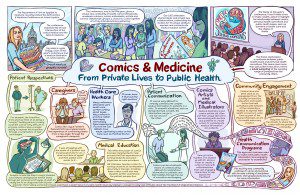 PATIENT PERSPECTIVES
PATIENT PERSPECTIVES
For example, the transition from what we think of as being a “normal,” healthy person to being a patient can be very difficult to process. Comics have a unique ability to express this transition through a combination of text and images. Graphic novels like Ellen Forney’s Marbles have helped destigmatize mental illness through her personal portrayals of what it’s really like to be diagnosed with bipolar disorder. Best-selling works like Forney’s could have a wider impact on public health issues by helping to change broadly held attitudes about the treatment of stigmatized illnesses.
CAREGIVERS
Comics like Joyce Farmer’s Special Exits have helped share the experience of confronting illness from a new angle: through the caregiver’s viewpoint.
HEALTH CARE WORKERS
Many conference attendees were health care workers writing about issues they confront in practice rather than simply internalizing these experiences. Doctors like Ian Williams have made captivating comics on this topic such as The Bad Doctor.
MEDICAL EDUCATION
This reflective power of comics has been implemented to help process the first experiences of nursing students and junior physicians as care providers. MK Czerwiec teaches comics to nursing students at Northwestern University inChicago. Creating these comics could also help students better understand the patient perspective.
PATIENT COMMUNICATION
It can be very difficult to verbally communicate complex medical information to patientsin a clinic. In stressful situations, such as during informed consent, the information cango in one ear and out the other. Comics can be a fantastic means of communicating difficult-to-understand informationto patients and their families through the use of narrative and imagery.
COMICS ARTISTS AND MEDICAL ILLUSTRATORS
Medical illustrators and comics artists will often put their unique skill set to use working with doctors and patient to create comics to communicate medical information forpatients. Here at Johns Hopkins I’ve teamed up with Dr. Monica Pearl to create a comic for kids with retinoblastoma that uses engaging characters to help explain the treatment.
HEALTH COMMUNICATION PROGRAMS
This approach has been used to make some public health information more engaging and easier to understand.
COMMUNITY ENGAGEMENT
Comics have also been used as an engagement tool. The Society for Nutrition Education and Health Action has held workshops with members of the community in Mumbai to express their health concerns in comic form as part of the Dharavi Biennaleand art for health advocacy project. They then took to the streets to share the comics with the greater community.
This exciting new community continues to grow and surprise with its wide variety of disciplines and interests. Visit graphicmedicine.org for more information.

